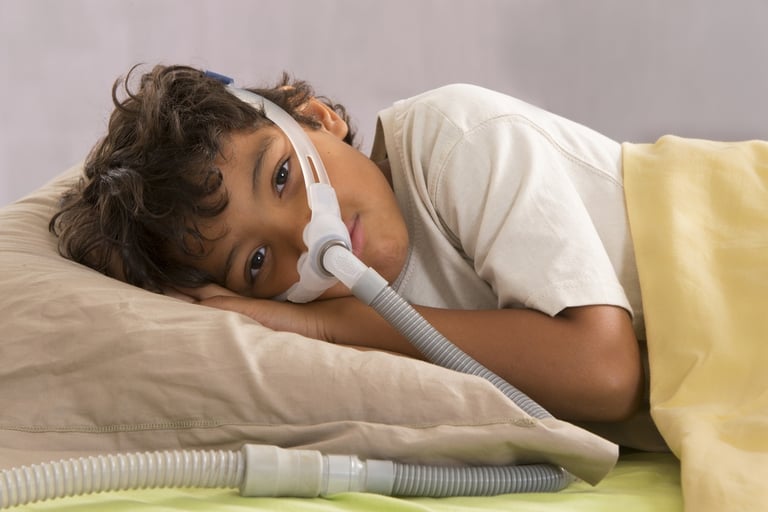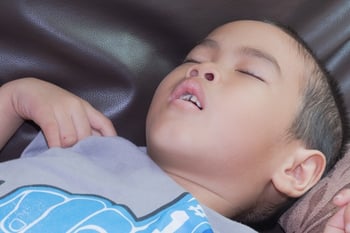 Yes, there are CPAP masks for children.
Yes, there are CPAP masks for children.
Kids Can Get Sleep Apnea?
Any person, any age, can fall victim to obstructive sleep apnea—from new-born infants to those over 100 years of age.
Sleep Disordered Breathing
Sleep disordered breathing (SDB) is a general term that includes breathing difficulties during sleep. Obstructive sleep apnea (OSA) is included in this classification, but also included are less severe (but still significant) breathing patterns, such as upper airway resistance and flow limitation.
Sleep apnea is a respiratory disorder that presents itself as a partial or complete closing of the airway during sleep. Many factors that affect breathing and the airway structure contribute to the risk of having sleep apnea.
OSA Symptoms in Children
OSA displays differently in pediatric patients tha n it does in adult patients. The following list is some of the signs, symptoms, and behaviors associated with OSA in children:
n it does in adult patients. The following list is some of the signs, symptoms, and behaviors associated with OSA in children:
Snoring
Gasping, choking during sleep
Large tonsils and adenoids
Increased work of breathing
Not breathing during sleep
Restlessness and moving during sleep (blankets can be totally entangled in the morning)
Sleeping with head hyperextended backwards
Nightmares
Nighttime bedwetting
Mouth breathing during the day
Difficulty waking up
Sleepy during the day
Failure to thrive
Difficulty concentrating
Poor school performance
Poor memory
Hyperactivity
Mood changes
Behavior problems
Hypertension
Obstructive sleep apnea is the partial or complete repeated closing of the airway during sleep. Children need oxygen, the same as adults do. During sleep, the brain and body construct, repair, restore and regenerate itself.
If the brain and body are not getting oxygen in adequate amounts, a child’s growth and development can be thwarted by this lack of oxygen. This lack of oxygen causes stress hormones to be released into the bloodstream.
Not only does the body and brain not have enough oxygen to do its jobs, it now has added “fight-or-flight” hormones coursing through the body, creating a disease-promoting environment.
Children’s rapid growth and development cause them to be even more vulnerable and susceptible to cell damage caused by this lack of oxygen during repetitive apneas.
Each child is an individual, and their response to the affects of sleep apnea will be different from another child’s. One child may have behavior problems as a result of OSA while another may be a star student but wet his bed at night.
 It is estimated that 30% of children who are diagnosed with ADHD really have obstructive sleep apnea. Children can be shamed for bedwetting, when in fact it may be the result of sleep disordered breathing and should be treated medically.
It is estimated that 30% of children who are diagnosed with ADHD really have obstructive sleep apnea. Children can be shamed for bedwetting, when in fact it may be the result of sleep disordered breathing and should be treated medically.
If your child shows any of the signs, symptoms or behaviors stated in the long list above, please have them evaluated for a sleep problem. You may be saving your child and yourself years of physical and/or mental discomfort by finding out the real reason.
Factors That Affect Pediatric Sleep Apnea
According to Dr. Mary Cataletto, in non-obese and otherwise healthy children under the age of 8 years old, the prevalence of OSA is one to three percent. Most children show symptoms of sleep apnea between 2-10 years of age. Those with severe obstructive sleep apnea are likely to show signs and symptoms at 3-5 years of age.
Snoring is the sound produced when air passes through a restricted airway caused by its partial closure. As the air passes through the restricted airway, the throat tissues in the airway will vibrate, causing the snoring noise.
Habitual snoring affects about 10 percent of children aged 2-8 years of age. If snoring begins within the first few months of life, the child’s chances are increased for sleep apnea.
Snoring can be a sign of sleep apnea or it can be just an annoying noise the person makes while sleeping, which does not adversely affect their sleeping, but may disrupt the nearby sleepers' sleep!
More Risk Factors
According to Tanya Weinstock, obstructive sleep apnea is strongly associated with race. Black children younger than 18 years of age are 3.5 times more likely to develop OSA than white children.
There is a strong association of sleep apnea and environmental tobacco smoke, according to Dr. Weinstock. Children who live in parent-smoking households are more likely to have sleep apnea than children living in non-smoking households.
 We have an obesity epidemic in our country. Pediatric obesity increases the risk of sleep disordered breathing 4 to 5 fold. OSA occurs in up to 60% of obese children.
We have an obesity epidemic in our country. Pediatric obesity increases the risk of sleep disordered breathing 4 to 5 fold. OSA occurs in up to 60% of obese children.
Obesity is a significant problem for our culture, and pediatric obesity has many implications, including a propensity toward adult obesity, and increases in diabetes rates and cardiovascular problems (hypertension, heart disease and stroke).
Adenotonsillectomy
Most children’s OSA is associated with large tonsils and adenoids. The first line of treatment in most children with OSA is adenotonsillectomy. This cures the OSA in about 75% of children. Some children, even after surgery, may still have airway obstruction due to large lymph nodes or other reasons.
Other children, such as obese patients and Down syndrome patients, may not be good candidates for surgery, requiring physicians to find other solutions for their OSA. For non-surgical candidates and those who have had surgeries that have not resolved the OSA, CPAP is the treatment of choice.
CPAP Treatment
In children, CPAP is usually the second choice due to pediatric low compliance rate. Like some adults, children have difficulty having a mask on for 8 or more hours per night.
Carole Marcus, a pediatrics professor at Children’s Hospital of Philadelphia, states that treatment for children’s obstructive sleep apnea can improve the quality of life and behavioral issues. Even though it is difficult to get many children to be compliant and use the therapy for an entire night or on a consistent basis, Dr. Marcus found that pediatric patients using CPAP for only three hours a night showed a big difference.
The results of Marcus's study indicated that in spite of suboptimal adherence rates, there was significant improvement in neurobehavioral function in children after 3 months of CPAP therapy, even in developmentally delayed children.
Pediatric CPAP Masks
Years ago there were very few choices and designs for pediatric CPAP masks. Children would be given a petite or small adult mask and hope for the best. Of course, those masks did not fit a child properly and leaks developed which thwarted the quality of treatment, or discomfort caused the child to refuse to use it.
 Mask manufacturers began making children’s masks a few years back to address the specific needs of children.
Mask manufacturers began making children’s masks a few years back to address the specific needs of children.
With more and more children being diagnosed with sleep apnea as a result of the pediatric obesity epidemic, treatment for these children has become a major focus in the sleep medicine field.
Mask manufacturers have developed different designs to give greater choice for patients.
Because children grow quickly, different pediatric masks fit different sized heads and faces. Until the last couple years, really small masks were not available. Currently masks available for infants to adolescents are on the market. Here is a list of the most current pediatric masks:
Respironics - Wisp Pediatric Nasal CPAP Mask - Philips Respironics (infants and up)
Respironics - Small Child Profile Lite CPAP Mask (1 year and older)
Circadiance - SleepWeaver Nasal CPAP Mask (2 – 7 years old)
ResMed - Pixi Pediatric CPAP Mask (2 years and older)
SleepNet - MiniMe 2 Nasal Pediatric Mask (2-12 years old)
ResMed - Mirage Kidsta Nasal CPAP Mask (7 years and older)
AG Industries - Nonny Pediatric Nasal CPAP Mask (fits children’s and small adults faces)
Respironics - Profile Lite Youth Size Gel Nasal CPAP Mask (fits children’s and small adult faces)
 Pediatric masks accommodate a child’s needs, as well as appeal to a child’s nature. Respironics’ Wisp pediatric nasal mask has a giraffe print design on the frame to make things fun, and Circadiance’s SleepWeaver Advanced pediatric nasal mask incorporates a fabric cushion that seals gently to the face to protect delicate facial skin.
Pediatric masks accommodate a child’s needs, as well as appeal to a child’s nature. Respironics’ Wisp pediatric nasal mask has a giraffe print design on the frame to make things fun, and Circadiance’s SleepWeaver Advanced pediatric nasal mask incorporates a fabric cushion that seals gently to the face to protect delicate facial skin.
Summary
Children suffer from obstructive sleep apnea like adults do, maybe more so. Their rapidly growing and changing bodies and minds are susceptible to the lack of oxygen and needed nutrients that sleep apnea steals from them.
The first line of treatment is surgery, removing the tonsils and adenoids. If surgery is not successful in curing sleep apnea, or if other conditions are causing the disorder, CPAP is the treatment of choice.
In the last few years pediatric CPAP masks designed for children’s faces have become more readily available to treat the devastating disorder of obstructive sleep apnea.
Sources:
Mary Cataletto, Childhood Sleep Apnea, http://emedicine.medscape.com
Carol Marcus, Effects of Positive Airway Pressure Therapy on Neurobehavioral Outcomes in Children with Obstructive Sleep Apnea. American Journal of Respiratory and Critical Care Medicine, May 1, 2012; 185(9): 998-1003.
Tanya Weinstock, Predictors of Obstructive Sleep Apnea Severity in Adenotonsillectomy Candidates, Sleep. 2/1/2014; 37(2): 261–269.
www.respironics.com
www.circadiance.com
www.cpap.com
Image sources:
www.shutterstock.com
www.resmed.com
www.respironics.com











Leave a comment